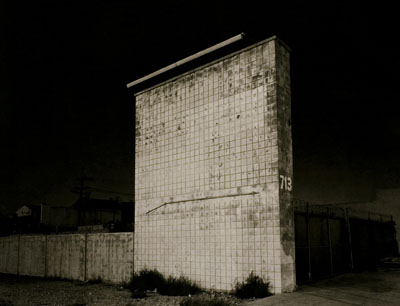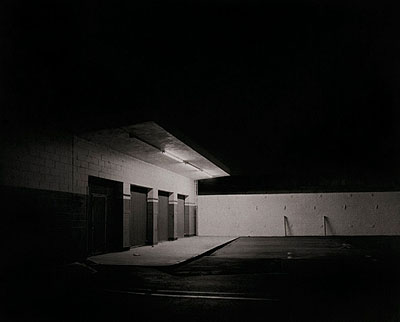
16 x 20 inches, edition of 10
21 x 26 inches, edition of 5
Scott B. Davis »
land of sunshine
Exhibition: 26 Jun – 6 Sep 2008

16 x 20 inches, edition of 10
21 x 26 inches, edition of 5
"I wanted to get out and walk southward toward the park through the soft twilight, but each time I tried to go I became entangled in some wild, strident argument which pulled me back, as if with ropes, into my chair. Yet high over the city our line of yellow windows must have contributed their share of human secrecy to the casual watcher in the darkening streets, and I was he too, looking up and wondering. I was within and without, simultaneously enchanted and repelled by the inexhaustible variety of life."- F. Scott Fitzgerald, The Great Gatsby
"How many of us are able to distinguish between the odors of noon and midnight, or of winter and summer, or of a windy spell and a still one? If man is so generally less happy in the cities than in the country, it is because all these variations and nuances of sight and smell and sound are less clearly marked and lost in the general monotony of gray walls and cement pavements." - Lin Yutang, The Importance of Living
The craftsmanship in the photography of Scott Davis is as important an element as his composition or concept. He began shooting 35mm and soon was mounting his camera to a tripod. The organic progression for him from there was to a view camera and Davis initially favored an 8x10 format. The physical limits of the large format camera as well as process of non-silver photography jived seamlessly with his pace and Davis relished the fact that he could work slowly in an otherwise fast-paced world. Moreover, the quality of light and clarity with any other process fell more than an eyelash short of his objectives. Yet, when prodded to make larger prints the problem arose of how to do so without incorporating a digital element for enlargement. Davis took the challenge on with vigor and he built himself a 16x20 camera that allows him to work in the method of his choice with the flexibility he previously was denied. Thus, his work has opened up the scale of his matte, inky vistas in a dramatic hand that allows for the glow evoked to impact even more profoundly a sense that the unexpected is always upon us.
During his career, Davis stumbled upon Charles Fletcher Lummis whose life has uncanny parallels to Davis' development. Like Davis, Lummis felt the call of the west and in 1884 embarked on a transcontinental walk from Cincinnati to Los Angeles to work as a writer for the Los Angeles Times. His gig as a writer went sour, but opened the door for him to travel extensively between New Mexico and California taking photos in situ that mirror the journeys and images taken by Davis. Lummis also worked on a publication named Land of Sunshine, which Davis had ironically already named his current body of work. Looking back on his life, Lummis found his change in career fulfilling in a way that he would not have if he had become, in his words, a "superannuated hack on the L.A. Times." Like Lummis, Davis went west with one ideal in mind, but found that photography was what enraptured his spirit.
Scott Davis' eye was educated and honed at an early age aboard flights with his father, who was a private pilot, and manifested in his brilliant ability to produce landscapes that continue the classic language of photography while subtlely broadening its vernacular. Working behind a camera was not Davis' inspiration to move west; rather, he was a Maryland bred surfer who was looking for the opportunity to reside where the waves were swelling. California gave him the Pacific as well as a job crafting surfboards. In time this existence proved more draining than romantic or peaceful, and a little voice creeped in drawing him to photography. Davis listened to the call that was rising and found his niche. Studying photography at the University of New Mexico proved to jigsaw with Davis' abilities and perspective. The conceptual philosophy of the institution allowed him to learn to treat photography like fine art and consider all angles when shooting. He was especially inspired working in the desert at night where he was brought face to face with the emptiness of the landscape that transpired into a style that is about existing darkness, rather than existing light. Thus, he is able to look at the world as a behemoth landscape then reduce it to a studied composition.
Upon returning to California after his studies in New Mexico, Davis took the unique moods of the desert and applied them with deftness to urban settings. By nature, Davis is a loner and seeks settings that can be as much one place as any other anonymous spot on a street or lost highway. His saturated nightscapes are composed with a single existing source whose light hugs and frames elements in the subject matter. This effect yields work that is luminescent in a manner that evokes night as much as day. You can feel the heat and lingering effects of drenching sunshine imbuing the streets, pavements, parking lots, buildings, valleys and billboards. Moreover, in his latest work he explores by taking pictures of buildings specifically on San Fernando Road. This focused survey has brought his work to a new plane that culminates his vision and training. In 713 N. Victory Boulevard, Davis captures a desolate corner that makes a viewer look twice because its richness and depth evoke a tangible painterly sensibility that makes one look back for confirmation that it is a photograph, rather than a hyper-real painting. There is no trace of Hollywood glamour; solitude is palpable and LA takes on a majesty unlike its actual, sprawling self. One can imagine if Edward Hopper were a photographer these are the pictures he would have taken.
Scott Davis studied photography at the University of New Mexico and currently holds the position of Director of Exhibitions at MoPA in San Diego, CA. He has mounted solo exhibitions at Etherton Gallery, Tucson, AZ; Michael Dawson Gallery, Los Angeles, CA; Shapiro Gallery, San Francisco, CA; The Farm, San Diego, CA; and the University of New Mexico, Albuquerque, NM. In 2009, Davis is slated for a solo show at the California Center for the Arts, Escondido, CA. Moreover, his work has been included in exhibitions at George Eastman House, Rochester, NY; Riverside Art Museum, Riverside, CA; Kiyosato Museum of Photographiic Arts, Kiyosato, Japan; and, Center for Photographic Art, Carmel, CA, among others. Davis' work has been acquired for the permanent collections of the California Museum of Photography, George Eastman House, Kiyosato Museum of Photographic Arts, Museum of Photographic Arts (San Diego), Nelson-Atkins Museum of Art, and the Santa Barbara Museum of Art as well as private collections. Furthermore, critical attention has been given to his work by View Camera, Image (The Magazine of George Eastman House), Camerawork, and various others.

16 x 20 inches, edition of 10
21 x 26 inches, edition of 5

16 x 20 inches, edition of 10
21 x 26 inches, edition of 5
